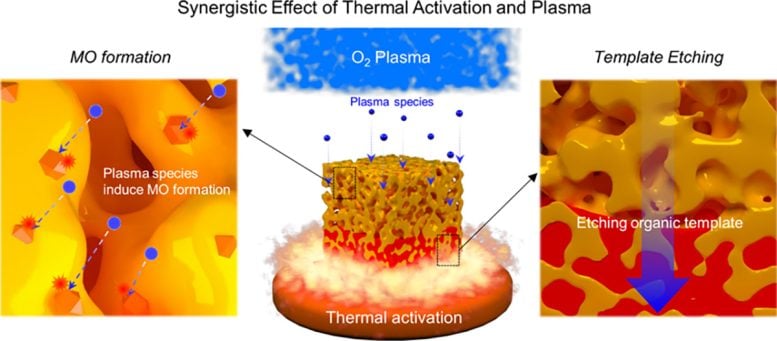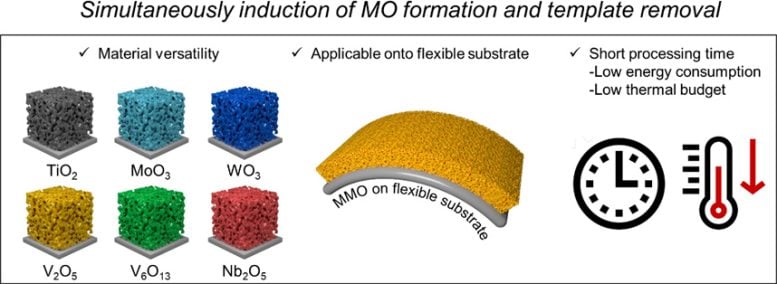
Synergistic effect of thermal activation and plasma. Credit: POSTECH
Imaging being able to wear your smartphone on your wrist, not as a watch, but literally as a flexible band that surrounds around your arm. How about clothes that charge your gadgets just by wearing them?
Recently, a collaborative team led by Professor Jin Kon Kim and Dr. Keon-Woo Kim of Pohang University of Science and Technology (POSTECH), Professor Taesung Kim and M.S./Ph.D. student Hyunho Seok of Sungkyunkwan University (SKKU), and Professor Hong Chul Moon of University of Seoul (UOS) has brought a step closer to making this reality. This research work was published in Advanced Materials
Challenges in Developing Flexible Devices
Mesoporous metal oxides (MMOs) are characterized by pores ranging from 2 to 50 nanometers (nm) in size. Due to their extensive surface area, MMOs have various applications, such as high-performance energy storage and efficient catalysis, <span class="glossaryLink" aria-describedby="tt" data-cmtooltip="
” data-gt-translate-attributes=”[{"attribute":"data-cmtooltip", "format":"html"}]” tabindex=”0″ role=”link”>semiconductors, and sensors.
However, the integration of MMOs on wearable and flexible devices remains a great challenge, because plastic substrates could not maintain their integrity at elevated temperatures (350°C or above) where MMOs could be synthesized.

Simultaneously induction of metal oxides formation and template removal. Credit: POSTECH
The research team tackled this problem by using the synergetic effect of heat and <span class="glossaryLink" aria-describedby="tt" data-cmtooltip="
” data-gt-translate-attributes=”[{"attribute":"data-cmtooltip", "format":"html"}]” tabindex=”0″ role=”link”>plasma to synthesize various MMOs including vanadium oxide (V2O5), renowned high-performance energy storage materials, V6O13, TiO2, Nb2O5, and WO3, on flexible materials at much lower temperatures (150 ~ 200 oC). The high reactive plasma chemical moieties provide enough energy that could be compensated by high temperature. The fabricated devices could be bent thousands of times without losing the energy storage performance.
Professor Jin Kon Kim, the leading researcher, expressed his opinion, stating: “We’re on the brink of a revolution in wearable tech. Our breakthrough could lead to gadgets that are not only more flexible but also much more adaptable to our daily needs.”
Reference: “Low-Temperature, Universal Synthetic Route for Mesoporous Metal Oxides by Exploiting Synergistic Effect of Thermal Activation and Plasma” by Keon-Woo Kim, Hyunho Seok, Sihoon Son, Su-Jeong Park, Chanwoo Yang, Dongho Lee, Hyo-Chang Lee, Jihun Mun, Hee-Jung Yeom, Min Young Yoon, Bomi Park, Se Hyun Kim, Changshin Jo, Hong Chul Moon, Taesung Kim and Jin Kon Kim, 19 January 2024, Advanced Materials.
DOI: 10.1002/adma.202311809
This research was supported by National Creative Initiative Research Program, the Basic Research in Science & Engineering Program, and the Nano & Material Technology Development Program.
